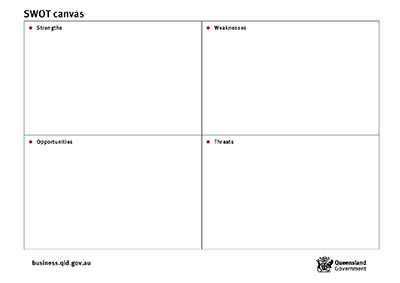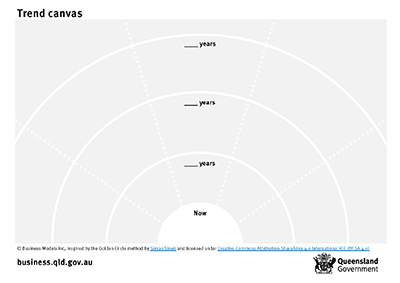Step 3 – Manage change
On this page
Turn on this option to focus on essential topics and actions in this step and hide optional parts.
- Assess and manage external and internal change
- SWOT canvas
- Know what to action first
- Trend canvas
Learning how to manage change is an important part of running a successful business.
So far in your change journey you will have:
- prepared for change by reviewing your personal goals and skills, engaging your team and identifying the type of change you need to action
- understood how to change by identifying external and internal changes relevant to your business.
The next step is to understand what will drive the performance of your business. This will help you know how to manage change.
Assess external and internal change
Essential
Learn about identifying your business's strengths, weaknesses, opportunities and threats, and complete a SWOT analysis activity to plot your path towards positive change.
SWOT analysis
A SWOT analysis will help you identify your strengths, weaknesses, opportunities and threats. It will show you:
- exactly how and where change may impact your business
- the decisions that are the most important for reducing risks
- how to improve the likelihood of successfully navigating change in your business
- what the world looks like in the future to assess the potential for future change or disruption.
Use information from the activities you've already completed to help you fill out your SWOT canvas.
- Your business model canvas will help you identify the strengths and weaknesses of your business.
- Categorise items from your context map canvas as either opportunities you can take advantage of or threats you need to shield your business from.
If you're facing a crisis from one particular threat (e.g. the COVID-19 pandemic), adapt your SWOT analysis to focus on that threat alone. Look at the strengths you can leverage, and the weaknesses you'll need to address. You can then come up with opportunities you can capitalise on.
-
What does your business do well? What are you proud of as a business owner? What keeps your customers coming back?
Use these examples to start exploring the strengths of your business.
- Large, loyal customer base generated over many years
- High quality products developed from years of testing and customer feedback
- Great customer service with many positive reviews
- Good relationships with suppliers that attracts loyalty discounts and mutual understanding during challenging times
-
What doesn’t your business do well? Where do you see room for improvement?
Use these examples to start thinking about your business's weaknesses.
- High production costs due to small product runs and not operating 24/7
- High staff turnover meaning additional training costs, reduced staff output and loss of experience and knowledge
- Lack of IT knowledge to feel confident in running online operations and managing social media
- Stagnant customer growth meaning little chance of increasing profits
-
What upcoming trends do you predict your business could take advantage of? What changes have you noticed in your market that could result in more business?
Use these examples to start thinking about the opportunities your business could take in the future.
- New technologies which could reduce production times and still produce high-quality products
- Different types of customer groups emerging in your local area
- Changing customer attitudes like support of local businesses, and appreciation of environmentally-friendly products
-
What potential trends or changes in your market are you concerned about? What obstacles or barriers will your business face in the future?
Use these examples to start thinking about potential threats to your business.
- New products from competitors that could make your products outdated or irrelevant
- Supplier shortages meaning you can't access key materials
- Economic situation changes with key customers no longer able to regularly afford your services

Complete your SWOT analysis
Use the SWOT canvas to analyse your business's strengths, weaknesses, opportunities and threats.
Download the SWOT canvas template or use our interactive SWOT analysis tool.
How to manage external and internal change
Managing change is key to ensuring a healthy business. Over time, you will develop an understanding of what you can and can't control.
To manage externally-driven change, you'll need to:
- anticipate opportunities and threats
- respond quickly to trends outside of your control
- proactively create opportunities
- reduce and eliminate threats.
Keep your SWOT canvas up to date and regularly review the opportunities and threats that may impact your business. From this, you can work out what internal shifts you can make to your business model to capitalise on opportunities and offset any threats.
When approaching any internal change, look at your business's strengths and weaknesses. Knowing how to work to the strengths of your business while reducing the impact of any weaknesses is key to managing the change itself.
Don't forget to consider the decision criteria you developed in your design criteria canvas. Make sure any internal shifts you plan to make are aligned with your must do or should do criteria.
This will mean you can:
- react faster to unforeseen change
- proactively shift your business to
- improve an existing strength or build a new one
- reduce or eliminate a weakness.
Know what to action first
Change will continually affect your business over the coming weeks, months and years. Prioritise your responses and actions to increase the likelihood of successfully managing change in your business.
After completing the SWOT canvas, you'll have a good idea of the opportunities and threats around your business. You must then work out which of these trends are likely to impact your business immediately, and which ones you have more time to plan for.
Complete a trend canvas to map out a timeline for when your identified opportunities and threats will impact your business.
Once you start to develop your actions in response to change, you can also plot your actions onto the trend canvas.
This will help you work out how soon you must take action, and what's possible in the time you have available.

Complete your trend canvas
The trend canvas will help you:
- map out when the external trends you've identified are likely to impact your business
- create a clear timeline for the internal actions you're taking to respond to each trend.
Download the trend canvas template.
This tool is inspired by the Golden Circle method by Simon Sinek and licensed under Creative Commons Attribution-ShareAlike 4.0 International (CC-BY-SA 4.0).